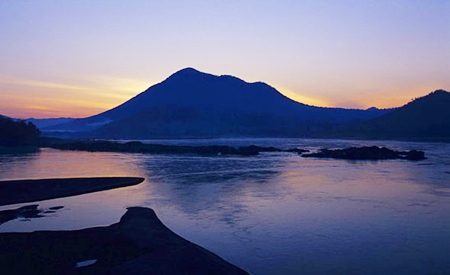The original locals of the Americas, Canada, and Europe used canoes and kayaks for travel and lived their lives beside rivers and seas. Later canoes and kayaks were used in sports and tourism.
Presently in Thailand, canoeing and kayaking are eco-adventure-tourism activities that are very popular among tourists because of the excitement and challenge in exploring and touring the scenery of coastal areas, islands, mangrove forests, bays, lakes, and rivers. They are also used in still waters; such as at reservoirs and dams as well as cave exploration without causing pollution or environmental harm.

Most of the accommodation providers have equipment and services for the guests to enjoy nature because kayaks and canoes can be used in both the sea as well as rivers. These are either free of charge, or rented hourly or daily.
The following is our first stop on our Thailand kayaking tour:
Kaeng Khutkhu, Mekong River
Tourists in Chiang Khan can now enjoy kayaking along the Mekong River from Chiang Khan (Wat Si Khun Mueang Pier) to “Kaeng Khutkhu”, a total of about 5 km. The kayaking usually starts at dawn. This part of the river is about 1 km wide. At some parts of the river, you can see rock plates, rocks, sandbars and huge dunes creating a charming classic view.

Many people name this area the “Sahara of Thailand”. The other good thing is you don’t have to put much effort into kayaking. You can just let the kayak float along the water flow while you are enjoying nature and the raft people’s lifestyle along the Khong River, which includes fishing and even panning for gold. You can also see the scenic Sana Kham town (Chanasongkhram) of Laos on the other side, and the shady rain trees.
After enjoying the surrounding view for a while, you will soon reach “Kaeng Khutkhu”, a group of large rocks standing in the middle of the Khong River. Kaeng Khud Khoo is almost large enough to connect two sides of the river, so it leaves only a little space for the water to flow. This point is the end of 2 hours kayaking before you head back to Chiang Khan.

Kayaking along Khong River is a new activity; so there are only a few experienced providers of this activity. For your safety, kayaking should be supervised by experts who know the water and the intensity of water flow, and have all necessary tools. You should never kayak alone. To kayak, you have to purchase a touring program from the provider.
Know Before You Go: In the rainy season, all rocks will be submerged. You should come after the rainy season around December to May.
Recommendation: The trip must be booked in advance. If you are a real river adventurer, you can continue paddling further to Pak Chom.

Please: Since Chiang Khan is a small town; it does not have a sophisticated waste disposing system. So if it is possible, please dispose any bottle or plastic bag at Loei town.
Travel Info: From Loei town, take Highway 201 until the riverfront and then turn left to Wat Si Khun Mueang Pier. It is where the journey starts; however, you need to reserve this activity in advance with the Mekong Culture & Nature Resort.
GPS Location: N17° 53.635°, E101° 39.149’
Contact: Mekong Culture & Nature Resort, +66 4282 1457, +668 9569 3470.
Facilities & Services: Guide, kayak, long-tail boat, accommodation, restroom and restaurant. (TAT)
Thailand Tourism Standards for Kayaking-Canoeing
To ensure the safety of tourists who choose to participate in Kayaking-Canoeing, the Department of Tourism, Ministry of Tourism and Sports, has issued the Thailand Tourism Standards for Kayaking-Canoeing operators and sites to provide guidelines on the sport with emphasis on safety for participants. For more information, visit http://www.tourism.go.th
Kayaking and Canoeing Regulations and Advice
Before getting into a kayak / canoe, proper preparations should be made for the trip so that enjoyment as well as safety can be had without affecting the natural environment.
· If planning your own trip, you must ask permission from the authorities responsible for the area; such as the Royal Forest Department.
· If choosing to use a tour operator, make sure to pick a company that is registered as such and check the itinerary and various agreements; such as insurance, equipment, and other services.
· Know your travel route and the direction of the waterway as well as the tides.
· Always wear a helmet and life-vest when on a boat.
· Bring only the necessities and prepare plastic bags or water-proof packs to put them in.
· Follow the advice of the guide.
· Be mentally prepared for possible obstacles and problems that may happen on your trip.




